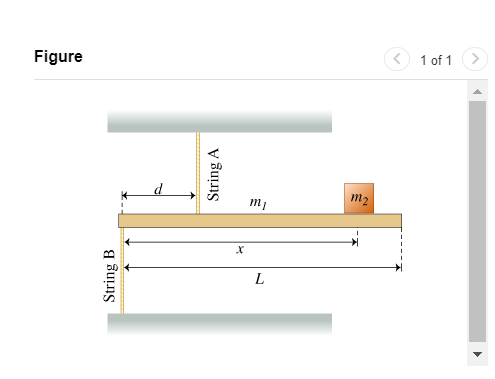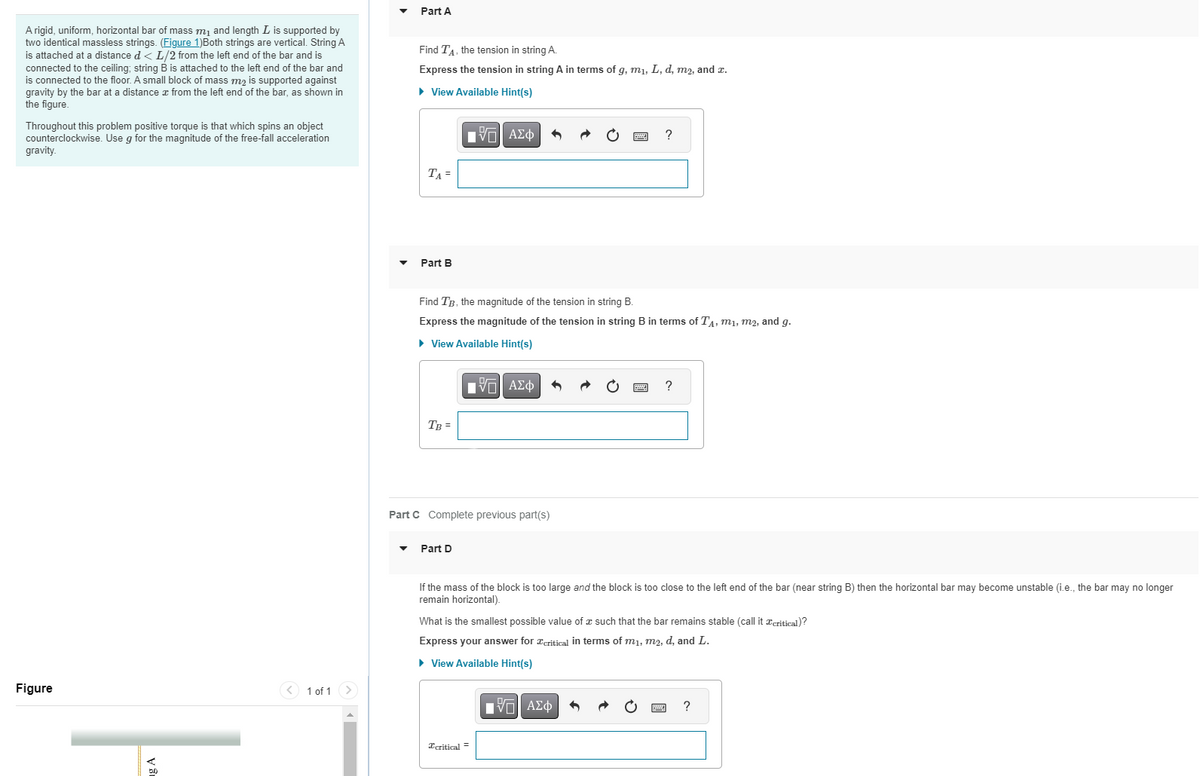A rigid, uniform, horizontal bar of mass my and length L is supported by two identical massless strings. (Eigure 1)Both strings are vertical. String A is attached at a distance d < L/2 from the left end of the bar and is connected to the ceiling; string B is attached to the left end of the bar and is connected to the floor. A small block of mass m₂ is supported against gravity by the bar at a distance from the left end of the bar, as shown in the figure. Throughout this problem positive torque is that which spins an object counterclockwise. Use g for the magnitude of the free-fall acceleration gravity. ▾ Find T₁. the tension in string A. Express the tension in string A in terms of g, m₂, L, d, m₂, and z. ▸ View Available Hint(s) 195] ΑΣΦΑ TA= Part B TB = Find TB, the magnitude of the tension in string B. Express the magnitude of the tension in string B in terms of T₁, m₁, m₂, and g. ▸ View Available Hint(s) IVE ΑΣΦ Part C Complete previous part(s) ▾ Part D → ? ? If the mass of the block is too large and the block is too close to the left end of the bar (near string B) then the horizontal bar may become unstable (i.e., the bar may no longer remain horizontal). What is the smallest possible value of a such that the bar remains stable (call it critical)?
A rigid, uniform, horizontal bar of mass my and length L is supported by two identical massless strings. (Eigure 1)Both strings are vertical. String A is attached at a distance d < L/2 from the left end of the bar and is connected to the ceiling; string B is attached to the left end of the bar and is connected to the floor. A small block of mass m₂ is supported against gravity by the bar at a distance from the left end of the bar, as shown in the figure. Throughout this problem positive torque is that which spins an object counterclockwise. Use g for the magnitude of the free-fall acceleration gravity. ▾ Find T₁. the tension in string A. Express the tension in string A in terms of g, m₂, L, d, m₂, and z. ▸ View Available Hint(s) 195] ΑΣΦΑ TA= Part B TB = Find TB, the magnitude of the tension in string B. Express the magnitude of the tension in string B in terms of T₁, m₁, m₂, and g. ▸ View Available Hint(s) IVE ΑΣΦ Part C Complete previous part(s) ▾ Part D → ? ? If the mass of the block is too large and the block is too close to the left end of the bar (near string B) then the horizontal bar may become unstable (i.e., the bar may no longer remain horizontal). What is the smallest possible value of a such that the bar remains stable (call it critical)?
Physics for Scientists and Engineers: Foundations and Connections
1st Edition
ISBN:9781133939146
Author:Katz, Debora M.
Publisher:Katz, Debora M.
Chapter14: Static Equilibrium, Elasticity, And Fracture
Section: Chapter Questions
Problem 57PQ: A copper rod with length 1.4 m and cross-sectional area 2.0 cm2 is fastened to a steel rod of length...
Related questions
Question
I need help with the attached question please.

Transcribed Image Text:Figure
String B
String A
X
L
m2
1 of 1

Transcribed Image Text:A rigid, uniform, horizontal bar of mass m₁ and length L is supported by
two identical massless strings. (Figure 1)Both strings are vertical. String A
is attached at a distance d < L/2 from the left end of the bar and is
connected to the ceiling; string B is attached to the left end of the bar and
is connected to the floor. A small block of mass m₂ is supported against
gravity by the bar at a distance from the left end of the bar, as shown in
the figure.
Throughout this problem positive torque is that which spins an object
counterclockwise. Use g for the magnitude of the free-fall acceleration
gravity.
Figure
ng A
< 1 of 1 >
Part A
▼
Find TA, the tension in string A.
Express the tension in string A in terms of g, m₁, L, d, m₂, and x.
► View Available Hint(s)
VE ΑΣΦ
TA=
Part B
Find TB, the magnitude of the tension in string B.
Express the magnitude of the tension in string B in terms of T₁, m₁, m2, and g.
► View Available Hint(s)
IVE ΑΣΦ
TB =
Part C Complete previous part(s)
Part D
?
If the mass of the block is too large and the block is too close to the left end of the bar (near string B) then the horizontal bar may become unstable (i.e., the bar may no longer
remain horizontal).
Ecritical =
?
What is the smallest possible value of a such that the bar remains stable (call it critical)?
Express your answer for critical in terms of m₁, m2, d, and L.
► View Available Hint(s)
IVE ΑΣΦ
Expert Solution
This question has been solved!
Explore an expertly crafted, step-by-step solution for a thorough understanding of key concepts.
This is a popular solution!
Trending now
This is a popular solution!
Step by step
Solved in 4 steps with 6 images

Knowledge Booster
Learn more about
Need a deep-dive on the concept behind this application? Look no further. Learn more about this topic, physics and related others by exploring similar questions and additional content below.Recommended textbooks for you

Physics for Scientists and Engineers: Foundations…
Physics
ISBN:
9781133939146
Author:
Katz, Debora M.
Publisher:
Cengage Learning

University Physics Volume 1
Physics
ISBN:
9781938168277
Author:
William Moebs, Samuel J. Ling, Jeff Sanny
Publisher:
OpenStax - Rice University

Physics for Scientists and Engineers, Technology …
Physics
ISBN:
9781305116399
Author:
Raymond A. Serway, John W. Jewett
Publisher:
Cengage Learning

Physics for Scientists and Engineers: Foundations…
Physics
ISBN:
9781133939146
Author:
Katz, Debora M.
Publisher:
Cengage Learning

University Physics Volume 1
Physics
ISBN:
9781938168277
Author:
William Moebs, Samuel J. Ling, Jeff Sanny
Publisher:
OpenStax - Rice University

Physics for Scientists and Engineers, Technology …
Physics
ISBN:
9781305116399
Author:
Raymond A. Serway, John W. Jewett
Publisher:
Cengage Learning